Yifei Zhou
FactorHD: A Hyperdimensional Computing Model for Multi-Object Multi-Class Representation and Factorization
Jul 16, 2025Abstract:Neuro-symbolic artificial intelligence (neuro-symbolic AI) excels in logical analysis and reasoning. Hyperdimensional Computing (HDC), a promising brain-inspired computational model, is integral to neuro-symbolic AI. Various HDC models have been proposed to represent class-instance and class-class relations, but when representing the more complex class-subclass relation, where multiple objects associate different levels of classes and subclasses, they face challenges for factorization, a crucial task for neuro-symbolic AI systems. In this article, we propose FactorHD, a novel HDC model capable of representing and factorizing the complex class-subclass relation efficiently. FactorHD features a symbolic encoding method that embeds an extra memorization clause, preserving more information for multiple objects. In addition, it employs an efficient factorization algorithm that selectively eliminates redundant classes by identifying the memorization clause of the target class. Such model significantly enhances computing efficiency and accuracy in representing and factorizing multiple objects with class-subclass relation, overcoming limitations of existing HDC models such as "superposition catastrophe" and "the problem of 2". Evaluations show that FactorHD achieves approximately 5667x speedup at a representation size of 10^9 compared to existing HDC models. When integrated with the ResNet-18 neural network, FactorHD achieves 92.48% factorization accuracy on the Cifar-10 dataset.
Thinking vs. Doing: Agents that Reason by Scaling Test-Time Interaction
Jun 09, 2025
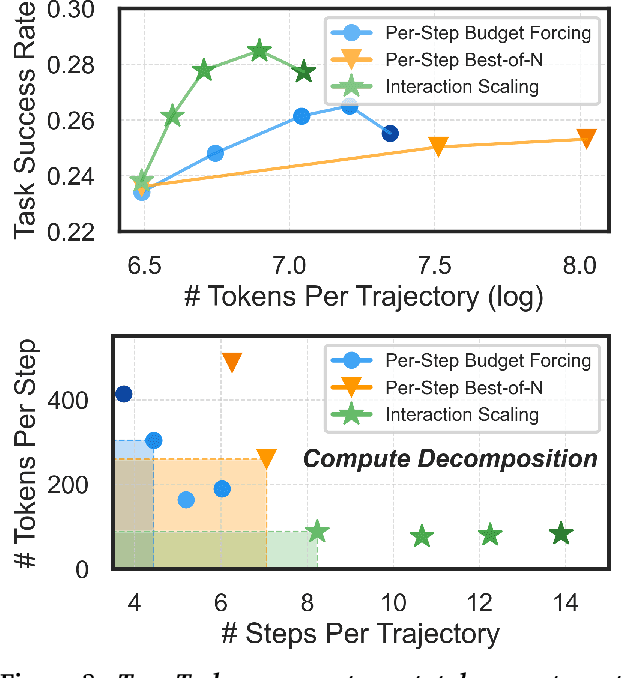


Abstract:The current paradigm of test-time scaling relies on generating long reasoning traces ("thinking" more) before producing a response. In agent problems that require interaction, this can be done by generating thinking traces before acting in the world. However, this process does not allow agents to acquire new information from the environment or adapt their behavior over time. In this work, we propose to scale test-time interaction, an untapped dimension of test-time scaling that increases the agent's interaction horizon to enable running rich behaviors such as exploration, backtracking, and dynamic re-planning within a single rollout. To demonstrate the promise of this scaling dimension, we study the domain of web agents. We first show that even prompting-based interaction scaling without any training can improve task success on web benchmarks non-trivially. Building on this, we introduce TTI (Test-Time Interaction), a curriculum-based online reinforcement learning (RL) approach that trains agents by adaptively adjusting their rollout lengths. Using a Gemma 3 12B model, TTI produces state-of-the-art open-source, open-data web agents on WebVoyager and WebArena benchmarks. We further show that TTI enables agents to balance exploration and exploitation adaptively. Our results establish interaction scaling as a powerful, complementary axis to scaling per-step compute, offering new avenues for training adaptive agents.
Learning Adaptive Parallel Reasoning with Language Models
Apr 21, 2025Abstract:Scaling inference-time computation has substantially improved the reasoning capabilities of language models. However, existing methods have significant limitations: serialized chain-of-thought approaches generate overly long outputs, leading to increased latency and exhausted context windows, while parallel methods such as self-consistency suffer from insufficient coordination, resulting in redundant computations and limited performance gains. To address these shortcomings, we propose Adaptive Parallel Reasoning (APR), a novel reasoning framework that enables language models to orchestrate both serialized and parallel computations end-to-end. APR generalizes existing reasoning methods by enabling adaptive multi-threaded inference using spawn() and join() operations. A key innovation is our end-to-end reinforcement learning strategy, optimizing both parent and child inference threads to enhance task success rate without requiring predefined reasoning structures. Experiments on the Countdown reasoning task demonstrate significant benefits of APR: (1) higher performance within the same context window (83.4% vs. 60.0% at 4k context); (2) superior scalability with increased computation (80.1% vs. 66.6% at 20k total tokens); (3) improved accuracy at equivalent latency (75.2% vs. 57.3% at approximately 5,000ms). APR represents a step towards enabling language models to autonomously optimize their reasoning processes through adaptive allocation of computation.
SWEET-RL: Training Multi-Turn LLM Agents on Collaborative Reasoning Tasks
Mar 19, 2025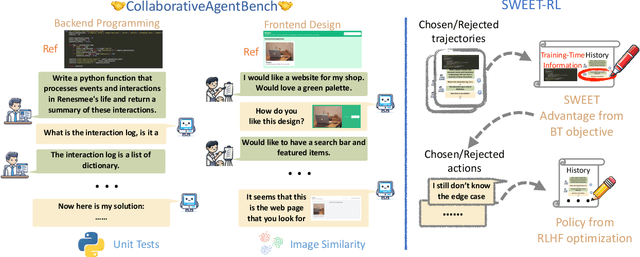

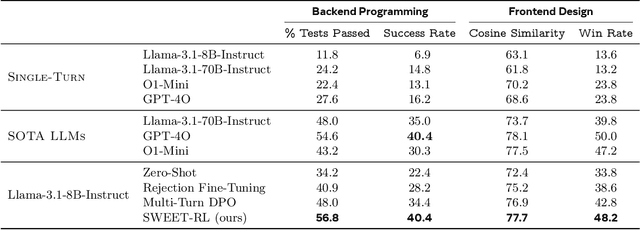

Abstract:Large language model (LLM) agents need to perform multi-turn interactions in real-world tasks. However, existing multi-turn RL algorithms for optimizing LLM agents fail to perform effective credit assignment over multiple turns while leveraging the generalization capabilities of LLMs and it remains unclear how to develop such algorithms. To study this, we first introduce a new benchmark, ColBench, where an LLM agent interacts with a human collaborator over multiple turns to solve realistic tasks in backend programming and frontend design. Building on this benchmark, we propose a novel RL algorithm, SWEET-RL (RL with Step-WisE Evaluation from Training-time information), that uses a carefully designed optimization objective to train a critic model with access to additional training-time information. The critic provides step-level rewards for improving the policy model. Our experiments demonstrate that SWEET-RL achieves a 6% absolute improvement in success and win rates on ColBench compared to other state-of-the-art multi-turn RL algorithms, enabling Llama-3.1-8B to match or exceed the performance of GPT4-o in realistic collaborative content creation.
Proposer-Agent-Evaluator(PAE): Autonomous Skill Discovery For Foundation Model Internet Agents
Dec 17, 2024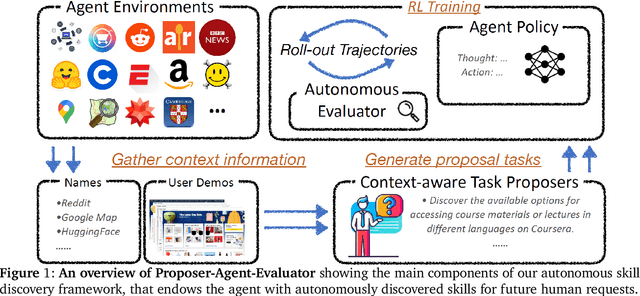
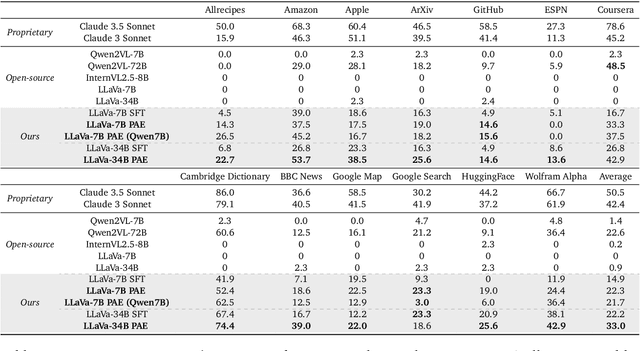
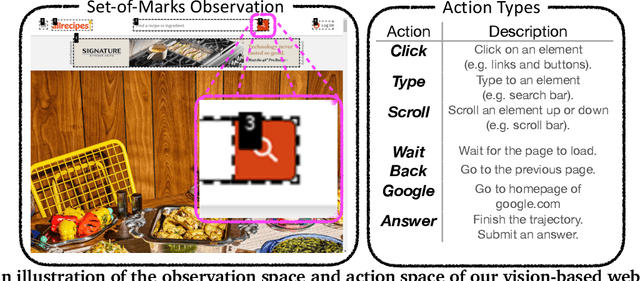
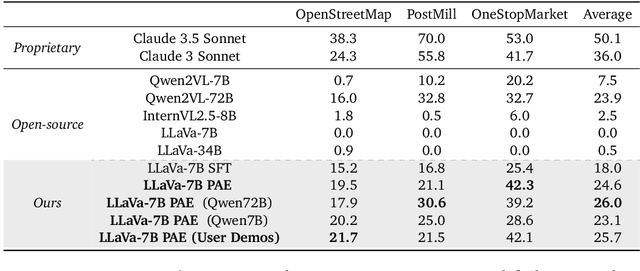
Abstract:The vision of a broadly capable and goal-directed agent, such as an Internet-browsing agent in the digital world and a household humanoid in the physical world, has rapidly advanced, thanks to the generalization capability of foundation models. Such a generalist agent needs to have a large and diverse skill repertoire, such as finding directions between two travel locations and buying specific items from the Internet. If each skill needs to be specified manually through a fixed set of human-annotated instructions, the agent's skill repertoire will necessarily be limited due to the quantity and diversity of human-annotated instructions. In this work, we address this challenge by proposing Proposer-Agent-Evaluator, an effective learning system that enables foundation model agents to autonomously discover and practice skills in the wild. At the heart of PAE is a context-aware task proposer that autonomously proposes tasks for the agent to practice with context information of the environment such as user demos or even just the name of the website itself for Internet-browsing agents. Then, the agent policy attempts those tasks with thoughts and actual grounded operations in the real world with resulting trajectories evaluated by an autonomous VLM-based success evaluator. The success evaluation serves as the reward signal for the agent to refine its policies through RL. We validate PAE on challenging vision-based web navigation, using both real-world and self-hosted websites from WebVoyager and WebArena.To the best of our knowledge, this work represents the first effective learning system to apply autonomous task proposal with RL for agents that generalizes real-world human-annotated benchmarks with SOTA performances. Our open-source checkpoints and code can be found in https://yanqval.github.io/PAE/
KALIE: Fine-Tuning Vision-Language Models for Open-World Manipulation without Robot Data
Sep 21, 2024Abstract:Building generalist robotic systems involves effectively endowing robots with the capabilities to handle novel objects in an open-world setting. Inspired by the advances of large pre-trained models, we propose Keypoint Affordance Learning from Imagined Environments (KALIE), which adapts pre-trained Vision Language Models (VLMs) for robotic control in a scalable manner. Instead of directly producing motor commands, KALIE controls the robot by predicting point-based affordance representations based on natural language instructions and visual observations of the scene. The VLM is trained on 2D images with affordances labeled by humans, bypassing the need for training data collected on robotic systems. Through an affordance-aware data synthesis pipeline, KALIE automatically creates massive high-quality training data based on limited example data manually collected by humans. We demonstrate that KALIE can learn to robustly solve new manipulation tasks with unseen objects given only 50 example data points. Compared to baselines using pre-trained VLMs, our approach consistently achieves superior performance.
DigiRL: Training In-The-Wild Device-Control Agents with Autonomous Reinforcement Learning
Jun 14, 2024Abstract:Training corpuses for vision language models (VLMs) typically lack sufficient amounts of decision-centric data. This renders off-the-shelf VLMs sub-optimal for decision-making tasks such as in-the-wild device control through graphical user interfaces (GUIs). While training with static demonstrations has shown some promise, we show that such methods fall short for controlling real GUIs due to their failure to deal with real-world stochasticity and non-stationarity not captured in static observational data. This paper introduces a novel autonomous RL approach, called DigiRL, for training in-the-wild device control agents through fine-tuning a pre-trained VLM in two stages: offline RL to initialize the model, followed by offline-to-online RL. To do this, we build a scalable and parallelizable Android learning environment equipped with a VLM-based evaluator and develop a simple yet effective RL approach for learning in this domain. Our approach runs advantage-weighted RL with advantage estimators enhanced to account for stochasticity along with an automatic curriculum for deriving maximal learning signal. We demonstrate the effectiveness of DigiRL using the Android-in-the-Wild (AitW) dataset, where our 1.3B VLM trained with RL achieves a 49.5% absolute improvement -- from 17.7 to 67.2% success rate -- over supervised fine-tuning with static human demonstration data. These results significantly surpass not only the prior best agents, including AppAgent with GPT-4V (8.3% success rate) and the 17B CogAgent trained with AitW data (38.5%), but also the prior best autonomous RL approach based on filtered behavior cloning (57.8%), thereby establishing a new state-of-the-art for digital agents for in-the-wild device control.
Fine-Tuning Large Vision-Language Models as Decision-Making Agents via Reinforcement Learning
May 17, 2024



Abstract:Large vision-language models (VLMs) fine-tuned on specialized visual instruction-following data have exhibited impressive language reasoning capabilities across various scenarios. However, this fine-tuning paradigm may not be able to efficiently learn optimal decision-making agents in multi-step goal-directed tasks from interactive environments. To address this challenge, we propose an algorithmic framework that fine-tunes VLMs with reinforcement learning (RL). Specifically, our framework provides a task description and then prompts the VLM to generate chain-of-thought (CoT) reasoning, enabling the VLM to efficiently explore intermediate reasoning steps that lead to the final text-based action. Next, the open-ended text output is parsed into an executable action to interact with the environment to obtain goal-directed task rewards. Finally, our framework uses these task rewards to fine-tune the entire VLM with RL. Empirically, we demonstrate that our proposed framework enhances the decision-making capabilities of VLM agents across various tasks, enabling 7b models to outperform commercial models such as GPT4-V or Gemini. Furthermore, we find that CoT reasoning is a crucial component for performance improvement, as removing the CoT reasoning results in a significant decrease in the overall performance of our method.
Autonomous Evaluation and Refinement of Digital Agents
Apr 10, 2024Abstract:We show that domain-general automatic evaluators can significantly improve the performance of agents for web navigation and device control. We experiment with multiple evaluation models that trade off between inference cost, modularity of design, and accuracy. We validate the performance of these models in several popular benchmarks for digital agents, finding between 74.4 and 92.9% agreement with oracle evaluation metrics. Finally, we use these evaluators to improve the performance of existing agents via fine-tuning and inference-time guidance. Without any additional supervision, we improve state-of-the-art performance by 29% on the popular benchmark WebArena, and achieve a 75% relative improvement in a challenging domain transfer scenario.
ArCHer: Training Language Model Agents via Hierarchical Multi-Turn RL
Feb 29, 2024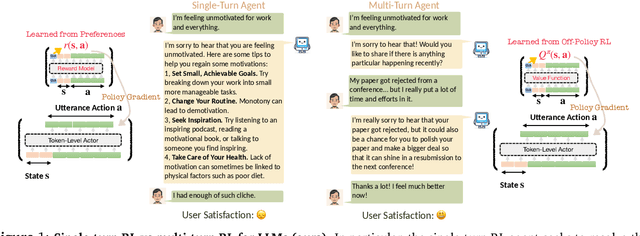
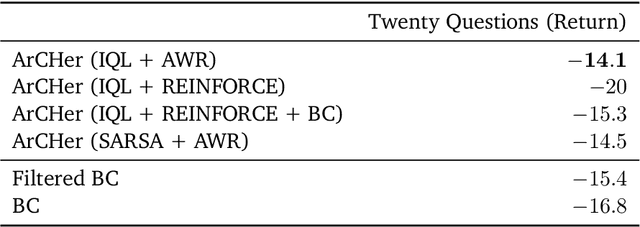
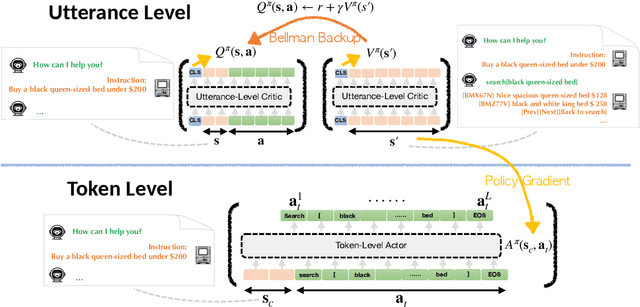

Abstract:A broad use case of large language models (LLMs) is in goal-directed decision-making tasks (or "agent" tasks), where an LLM needs to not just generate completions for a given prompt, but rather make intelligent decisions over a multi-turn interaction to accomplish a task (e.g., when interacting with the web, using tools, or providing customer support). Reinforcement learning (RL) provides a general paradigm to address such agent tasks, but current RL methods for LLMs largely focus on optimizing single-turn rewards. By construction, most single-turn RL methods cannot endow LLMs with the ability to intelligently seek information over multiple turns, perform credit assignment, or reason about their past actions -- all of which are critical in agent tasks. This raises the question: how can we design effective and efficient multi-turn RL algorithms for LLMs? In this paper, we develop a framework for building multi-turn RL algorithms for fine-tuning LLMs, that preserves the flexibility of existing single-turn RL methods for LLMs (e.g., proximal policy optimization), while accommodating multiple turns, long horizons, and delayed rewards effectively. To do this, our framework adopts a hierarchical RL approach and runs two RL algorithms in parallel: a high-level off-policy value-based RL algorithm to aggregate reward over utterances, and a low-level RL algorithm that utilizes this high-level value function to train a token policy within each utterance or turn. Our hierarchical framework, Actor-Critic Framework with a Hierarchical Structure (ArCHer), can also give rise to other RL methods. Empirically, we find that ArCHer significantly improves efficiency and performance on agent tasks, attaining a sample efficiency of about 100x over existing methods, while also improving with larger model capacity (upto the 7 billion scale that we tested on).
 Add to Chrome
Add to Chrome Add to Firefox
Add to Firefox Add to Edge
Add to Edge